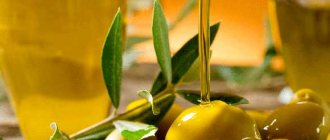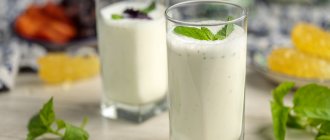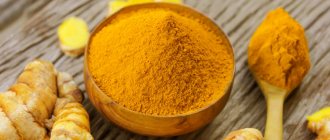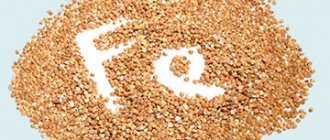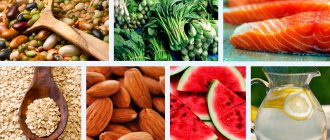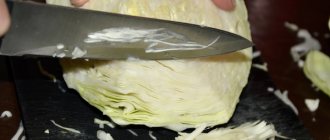The beneficial properties of spices lie not only in their bright taste - many are used as traditional medicine. One of them is turmeric - the queen of spices. It increases the shelf life of cooked dishes and adds a unique aroma to them. We tell you why pharmacists and doctors love it.
The spice's homeland is considered to be southeastern India - from here this plant from the ginger family began to spread throughout Burma, Vietnam, Cambodia, Pakistan, Iran and other warm countries, and then gained popularity in cooler regions of the world.
Turmeric is not only an excellent natural coloring agent (with its help butter and cheese acquire a pleasant yellowish tint), but also has unique medicinal properties. In Russia, turmeric is also called Indian saffron; the most popular dishes with it are rice, pilaf and chicken curry, to which this spice gives a golden color and a subtle bitterness. But few people are familiar with the beneficial properties of turmeric and its use for medicinal purposes.
The stems and rhizomes of the plant contain a large amount of vitamins B, K, C, as well as microelements - iodine, potassium, iron, phosphorus. The main active ingredient of the plant is curcumin, which has special healing properties. This is a substance from the class of polyphenols that has positive effects on various organs and systems of the body. Therefore, dosage forms and biological additives are created on its basis.
Beneficial properties of curcumin

Antioxidant that fights free radicals
Unstable atoms with open valence are constantly looking for a “pair”. By aggressively penetrating the cell structure, they contribute to the degeneration of cells into malignant ones. By destroying free radicals, antioxidants prevent the occurrence of cancerous tumors: it is no coincidence that according to research results, turmeric is listed as one of the means that helps fight cancer.
In particular, it is used for melanoma and its treatment with chemotherapy, since turmeric helps relieve symptoms after chemotherapy.
Natural antibiotic
Works as an anti-inflammatory agent, the effectiveness of which is comparable to pharmaceutical drugs. In eastern countries, even in the middle of the last century, many refused antibiotics and, in the old fashioned way, treated serious diseases with turmeric, including tuberculosis and pneumonia.
Wound healing agent
This property of turmeric was known in ancient times, when eastern warriors and hunters kept a bag of turmeric powder with them, which they sprinkled on open wounds. To this day, turmeric is used to treat external non-healing ulcers that are difficult to treat with other means.
A remedy for reducing the level of “bad” cholesterol in the blood and normalizing sugar levels
Regular consumption of turmeric (about 1/2 tsp per day) reduces cholesterol levels in the blood. In the prevention of diabetes, turmeric is used as a means of reducing cravings for sweets and slightly lowering blood sugar levels.
Helps normalize hormonal levels
This property of turmeric was discovered not so long ago. Studies have shown that regular consumption of turmeric maintains high levels of male and female sex hormones and helps maintain reproductive health into old age.
For men, turmeric helps improve sperm quality and increase libido: it is not without reason that before the night of love in India it is customary to eat meat dishes with curry seasoning.
- Normalizes blood pressure,
prevents the deposition of cholesterol plaques on the walls of blood vessels, preventing atherosclerosis.
- Helps regulate metabolism
and the work of the gastrointestinal tract, having carminative and choleretic effects.
- Purifies the blood
, increases the level of iron in the blood, which is useful for anemia, and has noticeable antiallergic properties.
- Insect bite repellent
, including poisonous ones: in the east, turmeric is still used to treat scorpion stings.
- Used to cleanse the body of toxins
(according to Ayurveda, turmeric is used in combination with barberry and gentian) and for effective weight loss (including in combination with ginger).
Foods containing unsaturated fats
Fish
Fish is one of the main suppliers of Omega-3 acids to the human body, while the share of Omega-6 is extremely insignificant, and Omega-9 is completely absent.
| Type of fish (portion 50 grams) | Omega-3(g) | Omega-6(g) |
| Fresh tuna | 0,82–0,122 | 0,005–0,034 |
| Fresh trout | 0,534 | 0,112 |
| Fresh mackerel | 0,807–1,335 | 0,058–0,109 |
| Fresh herring | 1,209 | 0,096 |
| Fresh cod | 0,110 | 0,004 |
| Fresh salmon | 1,293 | 0,086 |
| Fresh sardines | 0,740 | 0,055 |
| Caviar red and black | 3,395 | 0,040 |
Fish products have a certain specificity, which is expressed in the difference in acid content in the living conditions of the fish. So, sea fish feeds on algae and receives a huge amount of Omega-3 and a little Omega-6, while river fish or those raised on a farm and fed only with mixed feed have 2 times less Omega-3 content and 13-15 times more Omega-6.
A special place is occupied by fish oil, which is an oil and contains the same proportion of acids as fish products.
Seafood
Seafood is gradually gaining more and more popularity among the world's population, like fish, it occupies an important niche in providing fats to the human body and also does not contain Omega-9, maintaining the proportions.
| Type of seafood (50 gram portion) | Omega-3(g) | Omega-6(g) |
| Sea eel | 0,326 | 0,098 |
| Shrimps | 0,300 | 0,014 |
| Oysters | 0,370 | 0,016 |
| Scallop | 0,200 | 0,016 |
| Sea clam | 0,198 | 0,002 |

Seafood is a great alternative to fish in the everyday menu.
Vegetable oils
Vegetable oils are an integral attribute of modern cooking. Often used to improve the taste of dishes and prepare all kinds of salads. Consist of all types of unsaturated fatty acids and are divided into refined and unrefined
| Type of oil (portion 50 grams) | Omega-3(g) | Omega-6(g) | Omega-9(g) |
| Peanut | 0,003 | 16,700 | 2,358 |
| Coconut | – | 0,085 | 1,145 |
| Unrefined mustard | 2,823 | 11,743 | 8,321 |
| Hemp | 8,865 | 26,354 | 5,398 |
| Sesame | 0,004 | 20,151 | 3,563 |
| Flaxseed unrefined | 27,973 | 7,498 | 11,439 |
| Unrefined poppy seed | – | 36,411 | 8,739 |
| Almond | 0,005 | 15,158 | 4,697 |
| Unrefined olive | – | 6,459 | 38,712 |
| Palm unrefined | – | 1,245 | 16,774 |
| Sunflower unrefined | – | 30,522 | 15,296 |
| Sunflower refined | – | 9,157 | 3,964 |
| Rapeseed refined | 4,257 | 7,011 | 6,782 |
| Unrefined rapeseed | 4,567 | 11,254 | 10,543 |
| Soy | 5,451 | 25,729 | 1,528 |
| Cotton | – | 25,471 | 4,982 |
| Stone fruit (mixture) | – | 12,032 | 3,561 |
| Walnut oil | 5,282 | 27,459 | 4,653 |
| Avocado oil | 0,487 | 6,392 | 3,959 |

Vegetable oils are characterized by high levels of Omega-6 and low levels of Omega-3, although there is an exception in the form of flaxseed. It is very convenient to use a combination of fish and oils in cooking, maintaining a ratio of 1 to 4.
Flaxseed oil occupies a special place among oils. The high and proportionally correct content of polyunsaturated fats allows you to meet your daily requirement with just one teaspoon.
The cold pressing technique allows you to save the maximum amount of fat, try to choose just such oils.
Nuts and oil seeds
Nuts and oil seeds are foods that occupy an important place in the daily human diet. By eating nuts, you can easily increase your brain activity and effectively replenish fat reserves.
| Type of nuts or oil seeds (50 gram serving) | Omega-3(g) | Omega-6(g) | Omega-9(g) |
| Peanut | – | 8,341 | 4,622 |
| Walnuts | 3,423 | 1,784 | 1,445 |
| Mustard seeds | 0,911 | 2,688 | 0,452 |
| Sesame | – | 9,867 | 4,614 |
| Flaxseeds | 11,453 | 3,010 | 11,439 |
| Almond | – | 0,378 | – |
| Olives | – | 1,459 | 36,577 |
| Palm kernel | – | 0,681 | 5,714 |
| Sunflower seeds (high oleic) | – | 5,529 | 25,851 |
| Sunflower seeds | – | 16,395 | 3,643 |
| Rapeseed seeds | – | 5,019 | 0,473 |
| Soya beans | – | 4,729 | 1,328 |
| Cotton seeds | – | 9,471 | 3,952 |
| Pumpkin seeds | 0,005 | 2,785 | 5,044 |
| Macadamia | – | 1,422 | 0,491 |
Nuts and oilseeds can help you diversify your unsaturated fat intake.
Using raw, soaked nuts will speed up the absorption of polyunsaturated fats and allow the monounsaturated acids to interact with the saturated fats, breaking them down.
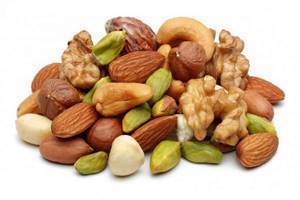
Meat and eggs
Meat products and eggs also contain small amounts of unsaturated fat. They consist of poultry, pork and chicken eggs and contain both monounsaturated and polyunsaturated fatty acids, but their amount is negligible compared to fish or nuts (up to 1 gram per 100 g of product).
- We recommend reading about chicken fat in the diet
There are two caveats when choosing meat products to replenish unsaturated fats:
- Meat contains a large amount of saturated (bad) fats;
- The amount of fat depends on the nature of feeding the animals (the more grass eaten, the better). Homemade meat and eggs have a higher percentage of fatty acids.
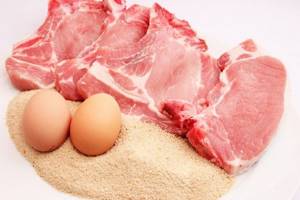
Vegetables
Vegetables represent the smallest segment of the list of foods with unsaturated fats. Greens (parsley, dill, cilantro) and leafy plants (broccoli, cauliflower and lettuce) contain a minimal amount of polyunsaturated acids (up to 0.1g per 100g of product) and are characterized by the absence of Omega-9.
Vegetables and fruits have virtually no value as sources of unsaturated fats.
What is useful in a home medicine cabinet?

- Used to disinfect infected burns and cuts;
- prevention of the development of Alzheimer's disease, multiple sclerosis, various types of tumors;
- has an antidepressant effect, improves mood and performance;
- used in complex anti-inflammatory therapy of arthritis, including rheumatoid;
- acts on lipid metabolism, helping to stabilize weight.
How many fatty acids does a person need?
How many fatty acids does a person need to stay healthy?
Nutritionists recommend composing your diet so that the amount of fat in your daily calorie intake does not exceed 30%.
For example, with a diet of 2000 calories - this norm is just suitable for a healthy woman who cares about the beauty of her figure - there should be no more than 60 g of fat in it. It is also recommended to observe the following proportions for fatty acids : 10% polyunsaturated, 60% monounsaturated and 30% saturated.
You can consume 70% animal fats and 30% vegetable fats. That's right, because animal fats also contain a lot of unsaturated fatty acids - you just don't need to exceed your daily calorie intake and choose more digestible foods.
The best option is to consume fats in natural products that retain most of the beneficial properties: fatty sea fish, olives, seeds, nuts, etc.
Excellent choices are cold-pressed unrefined vegetable oils, natural butter and lard. It is best to eat lard in salted form, little by little, rather than using it for frying. You can make lard from it - it is a very healthy product.
Refined oils and other processed fats, especially hydrogenated fats and oil substitutes, are the least beneficial. Consume different types of fats and oils - there are many of them in nature, and always follow the rules for storing them. Fats should not be stored in heat, light or open air. It is best to fry in olive oil and animal fat, such as clarified butter, and do not heat unrefined oils.
To protect the liver and gastrointestinal tract
Turmeric normalizes the functioning of the digestive system, kidneys, liver and gall bladder. But it also has antiparasitic and antifungal functions, as a result of which humanity was freed from the presence of Giardia in the body - this is how curcumin entered the history of medicine as a remedy that improves intestinal microflora
Curcumin helps maintain normal liver function and detoxification, protecting the main “filter” from the effects of free radicals and toxins, and also prevents the formation of gallstones. Equally important, curcumin helps regenerate liver tissue by restoring hepatocytes.
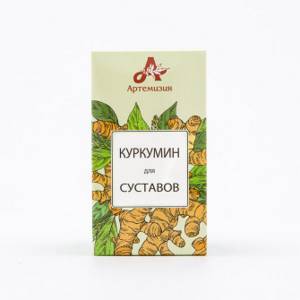
The dietary supplement “Curcumin for the Liver” was created based on curcumin.
, which contains only natural ingredients - dandelion and burdock roots, milk thistle seed extract, turmeric root extract, artichoke extract, and black pepper extract - piperine, which enhances absorption and increases the bioavailability of all components.
Daily Value of Unsaturated Fat
The daily norm is the required amount of food for the functioning of the body. The average number of calories per day is 2500 kcal, but may differ depending on gender, lifestyle, age and body condition. To find out your daily intake, use online calculators.
In what proportions should you consume unsaturated fats? Using the types of fatty acids (Omega-3, Omega-6, Omega-9), you can determine what exactly should be done.
- Omega-3 takes up 1–2% of the daily diet and amounts to 1–2 grams per day. This amount is contained in 75 grams of salmon, 110 g of sardines, 120 g of tuna, 20 g of rapeseed oil, 15 g of soaked walnuts.
- Omega-6 makes up 6-7% of the daily diet - 7-9 grams per day, which can be obtained from: 50 grams of peanuts, 25 g of sunflower seeds or a teaspoon of soybean or poppy seed oil.
- Omega-9 is replenished by the body on its own, and acute deficiency is compensated with a handful of any nuts per day.
It is important to observe several points of proper nutrition:
- It is worth nourishing the body with all types of fats, not only unsaturated ones, the share of which in the diet should not exceed 40%;
- Maintaining a balance between Omega-3 and Omega-6 containing products. Ratio 1:4 – for 1 g of Omega-3 you need 3-4 g of Omega-6;
- The norms may vary depending on the person’s condition; if you are sick, you should increase the intake of Omega-3 to 1:2 in relation to Omega-6.
THESE ARTICLES WILL HELP YOU LOSE WEIGHT
Your feedback on the article:
( 528 ratings, average: 4.51 out of 5)
Benefits of Curcumin for Liver and Curcumin for Joints
Consist only of natural ingredients.
Enhanced with extracts to optimize the liver: Dandelion and Burdock roots, Milk Thistle seed extract, Turmeric root extract - Curcumin, Artichoke extract, Black Pepper extract - Piperine.
The regenerating effect is enhanced by extracts of Milk Thistle, Artichoke, Dandelion and Burdock roots.
Curcumin for Joints is enhanced with anti-inflammatory extracts
- Sabelnik;
- white willow;
- ginger;
- licorice.
Bioavailability is greatly increased by black pepper extract
It has the ability to deliver substances quickly to their destination.
Warning
Most of these studies were of minor decision value. They were either small-scale or short-term studies in people based on self-administered dietary choices, or large-scale surveys of people. Additionally, some of these discovered health benefits of monounsaturated fats may be due to antioxidants or polyphenols in olive oil rather than the monounsaturated fatty acids (MUFAs) themselves.
Thus, according to the above studies, it cannot be said with 100% certainty that it is monounsaturated fats that are the true source of the identified health benefits. This fact once again indicates the need to choose real and high-quality olive oil , which contains large quantities of beneficial antioxidants and polyphenols .
Reduces inflammation

A diet high in monounsaturated fats helps:
- Reduce inflammatory processes;
- Activates the immune system;
- Helps your body fight infections.
Too much inflammation in the body can contribute to the development of chronic diseases, as well as obesity and heart disease.
A 2004 study published in the Journal of the American College of Cardiology reported that a traditional Mediterranean diet helped reduce inflammation and blood clotting. This explains the beneficial effects of this diet on the cardiovascular system.
